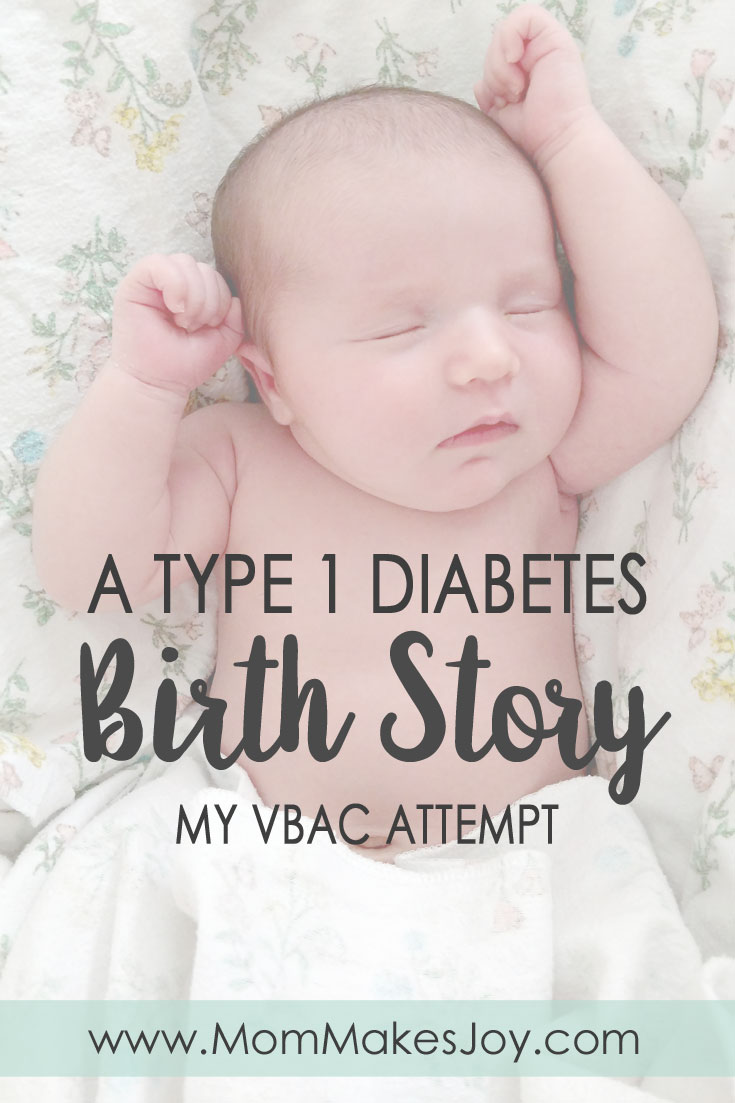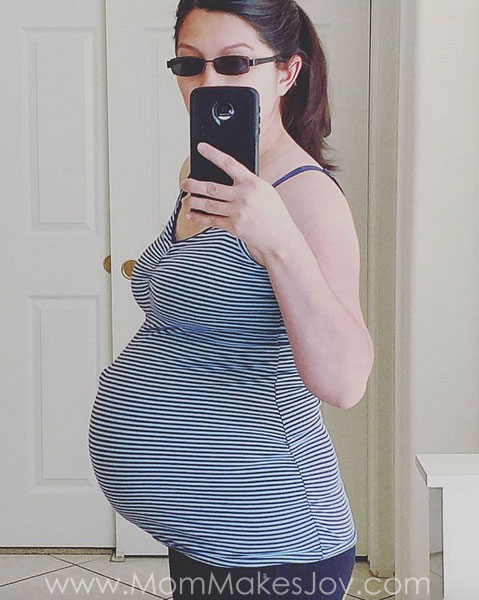Little Lo’s Birth Story: Part 1
This post may contain affiliate links (full disclosure policy). As an Amazon Associate, I earn from qualifying purchases.
New Readers Please Note: I have Type 1 Diabetes, which is an autoimmune disease caused when the body attacks and destroys the insulin producing cells in the pancreas; it cannot be prevented or reversed. This type of diabetes is different from the kinds of diabetes you hear about more often: Type 2 Diabetes (which is usually–but not always–caused by diet/lifestyle/age) and Gestational Diabetes (a short-term condition that only occurs during the tail-end of pregnancy). That said, my experience with pregnancy will probably be a bit different from someone who has Type 2 or Gestational Diabetes. Please keep this in mind if you are reading to learn a bit more about pregnancy with these other types of diabetes. To get a brief 411 on what Type 1 Diabetes really is, you can check out this FAQ post here!

Little Lo was born on June 25, 2018 at 2:55pm after 25 hours of labor. This is her birth story.
THE BACKSTORY
My first pregnancy was a whirlwind of anxiety and stress. My body did not feel like a safe space for my baby, and the sooner she could get out of it (while still making it to term, of course) the better. As someone who has lived in a body with type 1 diabetes for over 10 years now, I can assure you: This body is never a safe space.
So when I was told I “needed” a c-section with my first baby, I didn’t even let myself feel disappointment. I put on blinders to the fact that I cared about my birth experience. I told myself it didn’t matter. I told myself it was a luxury I couldn’t afford. I told myself I was just lucky to have a healthy baby. I told myself anything else was just silly.
The truth is, I was jealous. I was jealous of moms who got to skate through pregnancy, only having to worry about normal, run-of-the-mill pregnancy concerns instead of the heaps of other issues that can theoretically happen when you live with T1D. I was jealous of moms who had a birth story they were excited to tell.
I mean, technically I had a “birth story.” And it was a beautiful story simply by virtue of it being my daughter’s. But it wasn’t the story I wanted. And for a long time I felt guilty about that.
The truth is, my birth experience mattered to me.
BIRTH 2.0
When I found out I was pregnant with baby number two, I was determined to do things differently. This was going to be Pregnancy 2.0. This birth was my do-over. And I wasn’t going to be caught off guard like last time. I was going to take matters into my own hands as much as possible.

So I found a VBAC-friendly OB. I splurged on an amazing doula (which I dismissed as unnecessary the first go-around) who had VBA2C experience herself and who specialized in working with VBAC moms. I read the HypnoBirthing book (which I highly recommend) and a book on natural hospital births. I listened to hypnobirthing and hypnobabies relaxation tracks for weeks. I joined natural birth and VBAC support groups on Facebook. I saw a Webster Technique certified chiropractor. I learned about fetal positioning, sat pretty much exclusively on an exercise ball, did the Miles Circuit, and tried belly mapping. I ate dates. I drank red raspberry leaf tea. I took extra methylated folate the whole pregnancy.
And I prepped. We weren’t prepared AT ALL for my first baby coming home two weeks early, and I wasn’t going to be unprepared again. I stocked up on diapers, wipes, butt paste, paper plates and bowls, plastic forks and spoons, toilet paper and paper towels. I deep cleaned the house and re-washed my firstborn’s old baby clothes. I made 20 nights worth of freezer meals. A friend set up a meal train. And to avoid having my newborn stuffed with formula in the event she had a low blood sugar after birth (which can happen in babies of moms with T1D), I antenatally hand expressed three ounces of colostrum one. drop. at. a. time. starting at 34 weeks pregnant.
I was ready. Everything was all set and looking good: My weekly biophysical profiles and non-stress tests were all coming back beautiful.
My anxiety was well controlled, but I was still plagued with some worry. I knew I had done everything I could do so far to make a VBAC possible, but I was afraid that even if I legitimately needed a c-section, I would feel an overwhelming sense of disappointment (and perhaps even birth trauma, depending on the circumstances) regardless. And of course, I was worried about another tongue-tie interfering again with my breastfeeding journey this second time around.

So a couple days before my birth, I had called my grandma to ask her to pray for me. My aunt was at her house, and she grabbed the phone. All of my mom’s sisters (she has 5) are headstrong, take-charge women, and this aunt is no exception. She told me she knew I wanted a VBAC and that was great, but a VBAC might not be what I needed. I didn’t like hearing that–and it felt unsupportive, I won’t lie–but I heard her out. Rather than praying for a VBAC, she prayed that I would have the birth I needed. I could live with that.
FAST FORWARD
On Saturday, June 23rd, I was convinced my water had broken. I had gotten some PH strips the day before and tested the fluid that leaked, but it came back acidic (like normal vaginal secretions) and not alkaline (amniotic fluid has a PH of around 7-7.5). I went into labor and delivery anyway just in case, since there was just so MUCH fluid that had leaked. And of course, they sent me home.
Three hours later, my water definitely broke. I heard a little pop and a much larger trickle of fluid than I had ever felt before–like I peed myself a little bit, but I clearly didn’t. This fluid came back alkaline.
At this point I was torn. I didn’t want to go to the hospital and be put on a clock, but I was concerned about the risk of infection and what they would say given that I’m already a high risk pregnancy. My toddler had also been sick the day before with a fever of around 100-101, and I was getting over a sore throat and feeling some nasal congestion coming on. I was worried I might develop a fever, and the doctors would think it was an infection and insist upon a c-section.
So I waited an hour before calling my OBs office, and then waited another hour or so to make it to the hospital. When we got there, they confirmed it was amniotic fluid. I was having contractions once every 7 minutes or so, but I couldn’t feel them.
The OB on call was a sort of eccentric older gentleman I had never met, but I loved him right away. He said that rumor had it I was a “diabetes master,” (#flattered) and he was eager to learn about my continuous glucose monitor, my insulin pump, and how I managed my blood sugar. He said he was more than happy to let me self-manage my glucose levels (yes!), to let me deliver with a midwife (which is basically unheard of when you have T1D–double yes!), and to let me have 24 hours before we started talking about induction, even though policy was normally that baby had to be OUT by 24 hours (triple yes!). He also did gentle c-sections, should it come to that, complete with skin to skin in the OR and delayed cord clamping (quadruple yes!).
THE WAITING GAME
After he left, we got settled in our room. I sat down, ate dinner, my sister visited, and I twiddled my thumbs, waiting to feel a contraction and hoping the headache that had developed would go away. My sister and her husband visited with my husband while I tried to sleep, but thanks to whoever got my toddler sick, I wasn’t able to fall asleep until well after the 9am bedtime my doula gave me.
The next day, Sunday, was a waiting game. I walked, I danced, I tried to do more of the Miles Circuit, I bounced on a labor ball. Nothing. I tried to nap and couldn’t sleep. I cried. The Natural Hospital Birth book said that crying can be cathartic and sometimes is what’s needed to get things back on track.
It didn’t work.
But I cried anyway, because I really really didn’t want to be cut open again and my brain was spiraling to the worst-case scenario.
Every once in awhile a quiet lullabye would play on the speakers in the hallway outside my room, signaling that someone else had their baby. I was green with envy: All those moms getting to have the vaginal birth I wanted but might not get. But I kept walking, kept bouncing on my birth ball, hoping I’d get to hear my lullabye playing in the hallway soon.
INTENSITY
When 4:30 rolled around, my midwife told me it was time. Pitocin was started at 5pm, and was going to be turned up slowly every 30 minutes. By 8:51 pm when my doula arrived, I was having contractions about every minute, but I still wasn’t really feeling pain. They just felt like big uterus hugs.
The hugs were short lived.
Fortunately, my relaxation tracks came in handy. For the next 9 hours I was able to breathe through contractions with the help of some counter-pressure applied by my doula, a TENS unit she applied to my lower back, hip circles and some fancy positioning on the hospital bed. Unfortunately, my ability to really move or walk around was limited due to having to be hooked up to a continuous fetal monitor–and not one of the fancy belly sticker ones like I was expecting, but rather a clunky traditional one that would lose baby’s heartbeat just about every other contraction. A nurse was constantly adjusting it.

Call me a masochist, but apart from the frustration with the continuous monitor, I really loved labor. It hurt–a lot–but it was a strange kind of pain: It wasn’t the sharp, stabby kind of pain I’m used to. My doula called it intensity, and that is, I think, a much more accurate way of describing it.
I wish I could have ridden those waves longer, but by around 5am I felt like I was reaching my limit. In addition to trying to breathe and move through the pain of each wave, I was also dealing with the stress of checking my blood sugar as quickly as I could before the next contraction started, and it was growing harder and harder to make decisions about insulin dosing and glucose levels while trying to stay relaxed and focused on breathing. Not to mention the fact that I could not breathe through my nose this entire time thanks to whoever got my toddler sick the day before.
I had declined cervical checks since my water was broken and because I didn’t want to get discouraged by a number in my head. I was feeling growing pressure on my tailbone and the waves had grown stronger to the point where breathing through them was starting to become impossible. I had never delivered a baby before, but I felt like I might be close.
I needed to know there was a light at the end of the tunnel. If I was dilated to a 7, maybe even a 6, I felt like I could push through and keep going. But what if I was just a 3 or a 4? I would need to keep laboring for probably hours still, and I wasn’t sure I could do stronger pitocin without pain relief. I had already been awake for over 24 hours at this point, and the sleep I had gotten the night before was crappy and interrupted. I was reaching my limit, and not knowing my progress was agony. So I decided to get a cervical check.
I was only a “stretchy four.” Still just 70% effaced, like I was when I got to the hospital. The midwife could feel a bubble of water between my cervix and the baby’s head: The baby wasn’t helping my cervix dilate, and she was still at -2 station.
A TOUGH CALL
The decision to get an epidural wasn’t an easy one, but it made the most sense–even with hindsight being 20/20. The pitocin had been turned down from 11 to 6 at one point, and I thought I was still at 6 when they checked my cervix. Instead, I found out I had been brought back up to 10 in the meantime and just didn’t realize it. I was reaching the end of my rope, and the pitocin was going to have to be turned up significantly more than it already was and more than the most it had been so far.

I knew that epidurals slow down labor, but I thought that maybe if I was able to relax, get some sleep, they could turn up the pitocin as needed and things might still progress. They would rotate me in bed with a peanut ball too, in the hopes that baby would engage more. I knew I would wipe myself out if I kept going as I was. And although an epidural seemed like a bad idea, being utterly exhausted seemed like a bad idea too. I didn’t want the epidural, but it just seemed to make the most sense. So I went for it.
The epidural knocked out the pain, but I hated it. Unlike a spinal, the numbness from an epidural is more fluid. In other words, if you’re lying on your left side, your left leg will be more numb than your right. If you flip to your right side, the strength of the numbness travels to the right leg. It was a very jarring sensation. I fell into an uncomfortable half-sleep, drifting in an out, for four hours, praying that things would be better when I woke up.
Check out Part 2 of Little Lo’s birth story here!
Love,
Gabby
P.S. DISCLOSURE: This post may contains affiliate links, meaning I will receive a small commission on products purchased through these links at no extra cost to you. Rest assured I only promote products I use, love, and would recommend to a friend! Please see my FAQs and disclosure policy for more information. Thank you for your support!







